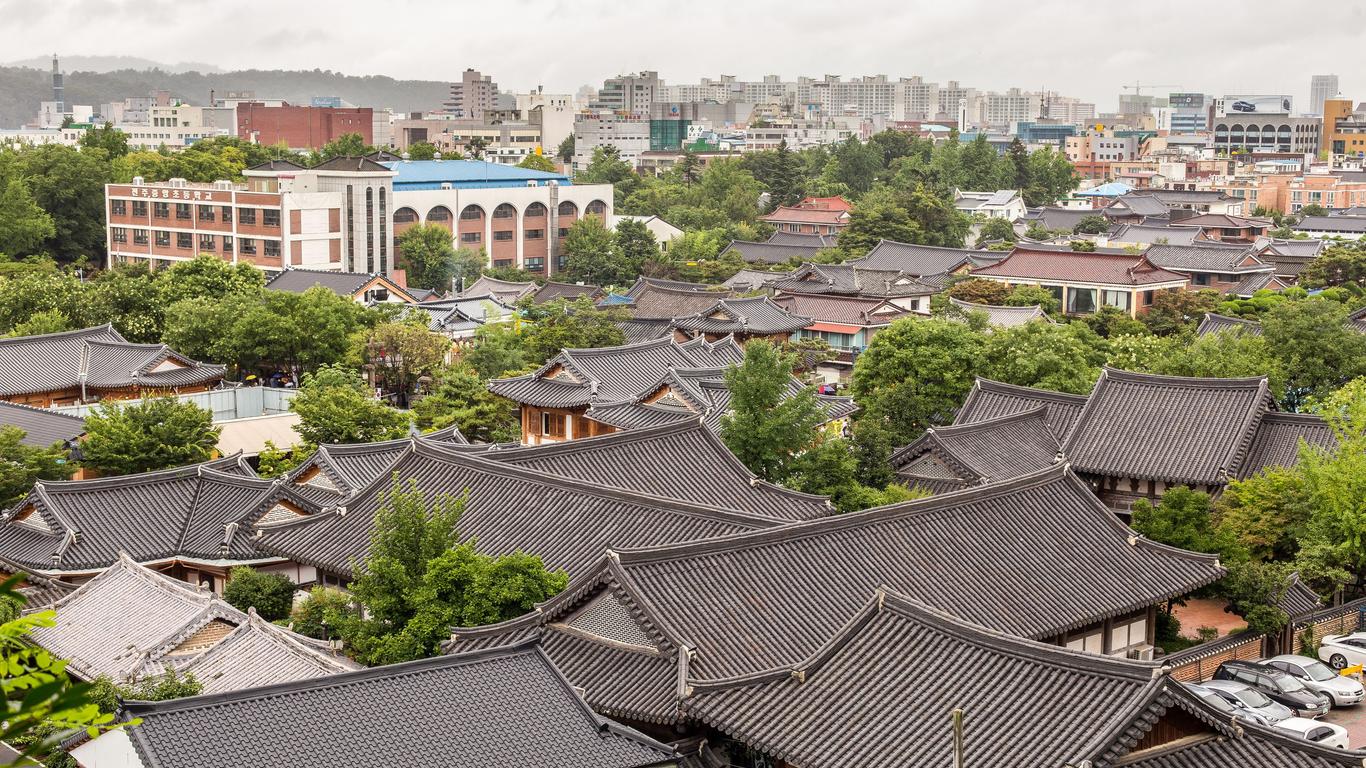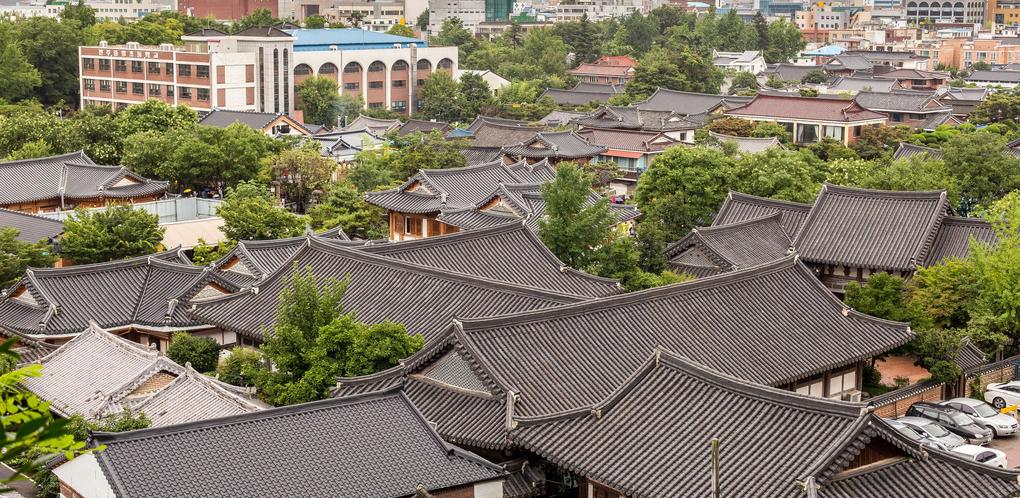
Jeonju travel guide
Jeonju Tourism | Jeonju Guide
You're Going to Love Jeonju
Urban life and rural charms meet in Jeonju, South Korea, capital of the North Jeolla Province. Famed for the local cuisine that arose from the farmlands that surround it, Jeonju was named a UNESCO City of Gastronomy in 2012. From the cobblestone streets and iconic hanok of the historic district to the mountains beyond the city limits, it's easy to see why this is one of the most popular destinations for Korean tourists.

Top 5 Reasons to Visit Jeonju
1. The Food
The people of Jeonju have a saying: "Eat once in Jeonju, and you'll be spoiled for life." The signature dish of Jeonju is bibimbap, or a traditional rice bowl with meat, egg, vegetables, and hot sauce.
2. Picturesque Local History
There are more than 800 hanoks, or traditional wooden Korean dwellings with their characteristic curved roofs, left in the city, most located in the Hanok Village and along the charming cobblestone streets of the historic district.
3. Sizzling Nightlife
Join the fun-loving spirit of the city at night in a busy scene of beer halls, karaoke bars, and the local specialty, makgeolli bars that serve the traditional unfiltered rice wine of the region.
4. Local Arts Scene
There is a fascinating local arts scene to explore, including the Jaman Mural Village with its outdoor murals.
5. Explore the Mountains
Explore the nearby mountains with excellent local connections via rail and bus, including the Naejangsan and Maisan peaks. The area is particularly beautiful in the fall.
What to do in Jeonju
1. Have A Wild Time!
The Jeonju Zoo is a visitor favorite, especially for its diverse facilities that include a soccer field, a volleyball court, and an amusement park known as "Dream-Land". The zoo itself is home to many diverse creatures such as tigers, lions, giraffes, hippos and even camels. Kids and adults alike can enjoy an afternoon at the zoo, with nearly 106 different species to engage with.
2. A Historic Landmark
Officially designated as a public park in 1978, the beautiful Deokjin Park is a favourite of visitors and residents alike. Its major draw is a sprawling, almost magical lake right at its center, whose surface is covered with lotus blossoms and lily pads. The park, which spans 13,000 square meters, also has a grand and majestic pavilion and a serene, tranquil water iris garden. There is a small arch bridge that is suspended over the lake, coupled with an artificial waterfall and nine stone monuments scattered around the park. This, coupled with the streams of couples walking and-in-hand around the park, makes Deokjin a walk to remember.
3. Food Hub Of South Korea
Jeonju is the food hub of South Korea and so a trip to the district would not be complete without visiting its street food hot spot, the Jeonju Nambu Traditional Market & Night Market! Open in the evenings until late, the night market serves up steak on a stick, freshly skewered and grilled, bacon rolls, octopus tentacles in light batter, dakkochi, fried sushi and even the traditionally loved bibimbap. For those who can't get enough, check out the Nambu Traditional Market, which is near Pungnammun Gate, Hanok Village.
4. Preserving Historical Culture
This present-day landmark is a bastion for the preservation of Korean history and culture. The National Museum was first established in 1990 to further research and preservation efforts, since there are so many sites in Jeonju that can be traced back to royal rulers and dynasties. Over the years, the museum has made considerable efforts to acquire some 30,000 artifacts from the Jeollabuk-do province of south-western South Korea. Of these, 1,300 are on display, organized in five distinct exhibits and one open-air hall. The magnificent structure includes dedicated spaces such as at the "Ancient Culture Room", focused on the prehistoric culture of the Jeonbuk area and the growth of the Baekje Dynasty, as well as the "Fine Arts Room", which brings together 350 relics, most of them Buddhist in origin. And, to preserve the spoken word, the museum also has a "Folklore" room.
5. A National Treasure
Some say it was built in 600, others say 599. Yet, all can agree that the Geumsansa Buddhist Temple has withstood the test of time, even if its first avatar was eventually destroyed by Japanese invaders. The structures were eventually rebuilt in 1635 and still showcase a large part of the progression of the Buddhist faith in Jeonju, especially the "prophecy" of a "Buddha of the Future".
1. Have A Wild Time!
The Jeonju Zoo is a visitor favorite, especially for its diverse facilities that include a soccer field, a volleyball court, and an amusement park known as "Dream-Land". The zoo itself is home to many diverse creatures such as tigers, lions, giraffes, hippos and even camels. Kids and adults alike can enjoy an afternoon at the zoo, with nearly 106 different species to engage with.
2. A Historic Landmark
Officially designated as a public park in 1978, the beautiful Deokjin Park is a favourite of visitors and residents alike. Its major draw is a sprawling, almost magical lake right at its center, whose surface is covered with lotus blossoms and lily pads. The park, which spans 13,000 square meters, also has a grand and majestic pavilion and a serene, tranquil water iris garden. There is a small arch bridge that is suspended over the lake, coupled with an artificial waterfall and nine stone monuments scattered around the park. This, coupled with the streams of couples walking and-in-hand around the park, makes Deokjin a walk to remember.
3. Food Hub Of South Korea
Jeonju is the food hub of South Korea and so a trip to the district would not be complete without visiting its street food hot spot, the Jeonju Nambu Traditional Market & Night Market! Open in the evenings until late, the night market serves up steak on a stick, freshly skewered and grilled, bacon rolls, octopus tentacles in light batter, dakkochi, fried sushi and even the traditionally loved bibimbap. For those who can't get enough, check out the Nambu Traditional Market, which is near Pungnammun Gate, Hanok Village.
4. Preserving Historical Culture
This present-day landmark is a bastion for the preservation of Korean history and culture. The National Museum was first established in 1990 to further research and preservation efforts, since there are so many sites in Jeonju that can be traced back to royal rulers and dynasties. Over the years, the museum has made considerable efforts to acquire some 30,000 artifacts from the Jeollabuk-do province of south-western South Korea. Of these, 1,300 are on display, organized in five distinct exhibits and one open-air hall. The magnificent structure includes dedicated spaces such as at the "Ancient Culture Room", focused on the prehistoric culture of the Jeonbuk area and the growth of the Baekje Dynasty, as well as the "Fine Arts Room", which brings together 350 relics, most of them Buddhist in origin. And, to preserve the spoken word, the museum also has a "Folklore" room.
5. A National Treasure
Some say it was built in 600, others say 599. Yet, all can agree that the Geumsansa Buddhist Temple has withstood the test of time, even if its first avatar was eventually destroyed by Japanese invaders. The structures were eventually rebuilt in 1635 and still showcase a large part of the progression of the Buddhist faith in Jeonju, especially the "prophecy" of a "Buddha of the Future".
Where to Eat in Jeonju
Get the best of local cuisine and the nightlife scene at Yetchon Makgeolli, where your first kettle of makgeolli or rice wine comes with pork belly and kimchi for ₩20,000. Enjoy classic bibimbap in Jeonju's enchanting historic district at Hanguk-jip, where prix fixe meals start at ₩11,000.
When to visit Jeonju
Jeonju's climate is very seasonal, with cold winters and summers where temperatures average over 85 degrees. Many visitors come to the city during the more temperate spring for the blossoms and fall for the changing colors of the leaves in the nearby mountains.
How to Get to Jeonju
Plane
The closest international airport is Seoul Incheon Airport (ICN), about 120 miles away. Express bus service to Jeonju costs about ₩15,000, and the trip takes about 2.5 hours.
Train
Jeonju Station is a regional hub, with extensive service to other major centers in South Korea from companies such as ITX-Saemaul, Mugunghwa-ho, and S-Train, along with the high-speed KTX bullet train route from Seoul to Busan.
Car
Jeonju is well connected to other major centers throughout the North Jeolla Province and beyond by an extensive network of highways.
Bus
The Intercity Bus Terminal connects Jeonju with other major centers in South Korea, along with sightseeing trips to the mountains in the region.
Airlines serving Jeonju
Where to stay in Jeonju
Stay in traditional style with all the modern amenities at Dan Kyung, steps away from the Hanok Village. Enjoy the sleek contemporary style of the Box Hotel, located just outside the historic district.
Popular Neighborhoods in Jeonju
Hanok Maeul - the city's historic center is where you will find one of the largest assemblies of elegant traditional hanok buildings in the country, along with other attractions such as the Gyeonggijeon Shrine, built in 1410.
Jaman Mural Village - located along a ridge between the Omokdae and Imokdae hills, overlooking the city from the foot of Seungamsan Mountain. The historic site is now home to streets of murals painted by local artists, along with galleries and boutiques.
Deokjin-gu - this green area of the city is where you will find the large Deokjin Park, centered around a natural pond with iris gardens and lotus blooms, an artificial waterfall, and much more.
Where to stay in popular areas of Jeonju
Most booked hotels in Jeonju
How to Get Around Jeonju
Public Transportation
There is an extensive network of public bus routes through the city, with a flat fare system that starts at ₩1,100.
Taxi
Taxis are plentiful throughout the city, with fares that start at ₩2,800. A typical fare within the city runs about ₩5,000 to ₩10,000.
Car
While public transit service is very good in Jeonju, a car rental lets you easily explore the region. A compact rental starts at about ₩86,100.
The Cost of Living in Jeonju
Shopping Streets
For locally produced artisan craft work, you'll want to check out the Jeonju Crafts Exhibition Hall, along with other shops and boutiques in the city's historic district.
Groceries and Other
Home Plus, Lotte Mart, and Megamart are three of the larger supermarket chains in the city. A quart of milk costs about ₩2,265 and a dozen eggs comes in at about ₩2,450.
